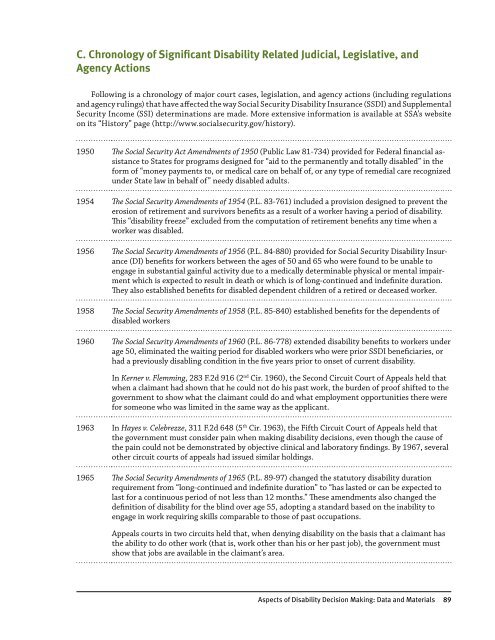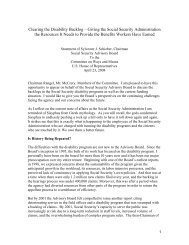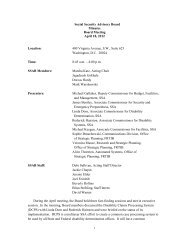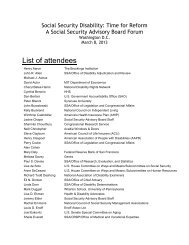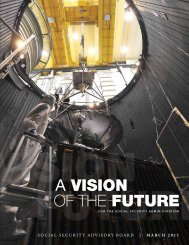claimants or their appointed representative mustfile the appeal request in writing within 60 daysfrom the date the notice <strong>of</strong> unfavorable decisionis received. If the claimant does not take the nextstep within the stated time period, he or she losesthe right to further administrative review <strong>and</strong> theright to judicial review <strong>of</strong> this particular claim,unless good cause can be shown for failure to makea timely request.ReconsiderationGenerally, the reconsideration is the first level<strong>of</strong> appeal <strong>and</strong> consists <strong>of</strong> a DDS case review. It issimilar to the initial determination process exceptthat it is assigned to a different disability examiner<strong>and</strong> physician/psychologist team. Claimantsare given the opportunity to present additionalevidence to supplement the information that wassubmitted when the original decision was made.If the reconsideration team concurs with theinitial denial <strong>of</strong> benefits, the individual may thenrequest a hearing before an ALJ in the Office<strong>Disability</strong> Adjudication <strong>and</strong> Review.Administrative Law Judge HearingAdministrative law judges (ALJs) are based inthe 169 hearing <strong>of</strong>fices (including seven satellite<strong>of</strong>fices) located throughout the nation. At the hearing,claimants <strong>and</strong> their representatives may appearin person (or by videoconference), submit new evidence,examine the evidence used in making thedetermination under appeal, <strong>and</strong> present <strong>and</strong> questionwitnesses. The ALJ may request medical <strong>and</strong>vocational experts to testify at the hearing <strong>and</strong> mayrequire the claimant to undergo a consultative medicalexamination. The ALJ issues a decision based onthe hearing record <strong>and</strong>, in cases where the claimantwaives the right to appear at the hearing, the ALJmakes a decision based on the evidence that is in thefile <strong>and</strong> any new evidence that has been submittedfor consideration.DDSs <strong>and</strong> ALJs approach the decision makingprocess differently. DDSs conduct a paper review <strong>of</strong>a claimant’s medical <strong>and</strong> vocational evidence, whileALJs hold face-to-face hearings <strong>and</strong> have the opportunityto observe the claimants firsth<strong>and</strong>. Due tothe passage <strong>of</strong> time between the two decisions, ALJs<strong>of</strong>ten receive information that was not available tothe DDS <strong>and</strong> was not considered in that determination.In addition, hearings are more likely to involvepr<strong>of</strong>essional representation. Another difference isthe instructional basis for the decision; DDS adjudicatorsuse instructions found in SSA’s ProgramOperations Manual System (POMS) while ALJs relydirectly on the law <strong>and</strong> regulations. SSA is currentlyworking on an electronic case analysis tool thatwill bridge the two determination st<strong>and</strong>ards <strong>and</strong>improve both the quality <strong>and</strong> consistency <strong>of</strong> decisionsat all levels. Many experts contend that theseare some <strong>of</strong> the differences in the decision makingprocess that contribute to the high number <strong>of</strong> DDSdecisions that are reversed at the hearing level.Appeals Council ReviewSSA’s final administrative appeals step is tothe Appeals Council. If the claimant is dissatisfiedwith the hearing decision, he or she may requestthat the Appeals Council review the case. TheCouncil, made up <strong>of</strong> administrative appeals judges,may also, on its own motion, review a decisionwithin 60 days <strong>of</strong> the ALJ’s decision.The Appeals Council considers the evidence <strong>of</strong>record, any allowable additional evidence submittedby the claimant, <strong>and</strong> the ALJ’s findings <strong>and</strong>conclusions. The Council may grant, deny, or dismissa request for review. If it agrees to review thecase, the Council may uphold, modify, or reversethe ALJ’s action, or it may rem<strong>and</strong> it to the ALJso that he or she may hold another hearing <strong>and</strong>issue a new decision. The Appeals Council mayalso rem<strong>and</strong> a case in which additional evidence isneeded or additional action by the ALJ is required.The Appeals Council’s decision, or the decision<strong>of</strong> the ALJ if the request for Appeals Councilreview is denied, is binding unless the claimantfiles an action in a Federal District Court.Judicial AppealsFederal District CourtClaimants may file an action in a Federal DistrictCourt within 60 days after the date they receivenotice <strong>of</strong> the Appeals Council’s action. In fiscalyear 2010, 13,229 new Social Security cases wereappealed to the district courts, representing lessthan 5 percent <strong>of</strong> the district court civil caseload.Circuit Court <strong>of</strong> Appeals <strong>and</strong> Supreme CourtIf the U.S. District Court reviews the caserecord <strong>and</strong> does not find in favor <strong>of</strong> the claimant,the claimant can continue with the legal appealsprocess to the U.S. Circuit Court <strong>of</strong> Appeals <strong>and</strong>ultimately to the Supreme Court <strong>of</strong> the UnitedStates. The Social Security Administration may,similarly, appeal district or circuit court decisionsthat are favorable to the claimant.88 <strong>Aspects</strong> <strong>of</strong> <strong>Disability</strong> <strong>Decision</strong> <strong>Making</strong>: <strong>Data</strong> <strong>and</strong> <strong>Materials</strong>
C. Chronology <strong>of</strong> Significant <strong>Disability</strong> Related Judicial, Legislative, <strong>and</strong>Agency ActionsFollowing is a chronology <strong>of</strong> major court cases, legislation, <strong>and</strong> agency actions (including regulations<strong>and</strong> agency rulings) that have affected the way Social Security <strong>Disability</strong> Insurance (SSDI) <strong>and</strong> SupplementalSecurity Income (SSI) determinations are made. More extensive information is available at SSA’s websiteon its “History” page (http://www.socialsecurity.gov/history).1950 The Social Security Act Amendments <strong>of</strong> 1950 (Public Law 81-734) provided for Federal financial assistanceto States for programs designed for “aid to the permanently <strong>and</strong> totally disabled” in theform <strong>of</strong> “money payments to, or medical care on behalf <strong>of</strong>, or any type <strong>of</strong> remedial care recognizedunder State law in behalf <strong>of</strong>” needy disabled adults.1954 The Social Security Amendments <strong>of</strong> 1954 (P.L. 83-761) included a provision designed to prevent theerosion <strong>of</strong> retirement <strong>and</strong> survivors benefits as a result <strong>of</strong> a worker having a period <strong>of</strong> disability.This “disability freeze” excluded from the computation <strong>of</strong> retirement benefits any time when aworker was disabled.1956 The Social Security Amendments <strong>of</strong> 1956 (P.L. 84-880) provided for Social Security <strong>Disability</strong> Insurance(DI) benefits for workers between the ages <strong>of</strong> 50 <strong>and</strong> 65 who were found to be unable toengage in substantial gainful activity due to a medically determinable physical or mental impairmentwhich is expected to result in death or which is <strong>of</strong> long-continued <strong>and</strong> indefinite duration.They also established benefits for disabled dependent children <strong>of</strong> a retired or deceased worker.1958 The Social Security Amendments <strong>of</strong> 1958 (P.L. 85-840) established benefits for the dependents <strong>of</strong>disabled workers1960 The Social Security Amendments <strong>of</strong> 1960 (P.L. 86-778) extended disability benefits to workers underage 50, eliminated the waiting period for disabled workers who were prior SSDI beneficiaries, orhad a previously disabling condition in the five years prior to onset <strong>of</strong> current disability.In Kerner v. Flemming, 283 F.2d 916 (2 nd Cir. 1960), the Second Circuit Court <strong>of</strong> Appeals held thatwhen a claimant had shown that he could not do his past work, the burden <strong>of</strong> pro<strong>of</strong> shifted to thegovernment to show what the claimant could do <strong>and</strong> what employment opportunities there werefor someone who was limited in the same way as the applicant.1963 In Hayes v. Celebrezze, 311 F.2d 648 (5 th Cir. 1963), the Fifth Circuit Court <strong>of</strong> Appeals held thatthe government must consider pain when making disability decisions, even though the cause <strong>of</strong>the pain could not be demonstrated by objective clinical <strong>and</strong> laboratory findings. By 1967, severalother circuit courts <strong>of</strong> appeals had issued similar holdings.1965 The Social Security Amendments <strong>of</strong> 1965 (P.L. 89-97) changed the statutory disability durationrequirement from “long-continued <strong>and</strong> indefinite duration” to “has lasted or can be expected tolast for a continuous period <strong>of</strong> not less than 12 months.” These amendments also changed thedefinition <strong>of</strong> disability for the blind over age 55, adopting a st<strong>and</strong>ard based on the inability toengage in work requiring skills comparable to those <strong>of</strong> past occupations.Appeals courts in two circuits held that, when denying disability on the basis that a claimant hasthe ability to do other work (that is, work other than his or her past job), the government mustshow that jobs are available in the claimant’s area.<strong>Aspects</strong> <strong>of</strong> <strong>Disability</strong> <strong>Decision</strong> <strong>Making</strong>: <strong>Data</strong> <strong>and</strong> <strong>Materials</strong> 89


